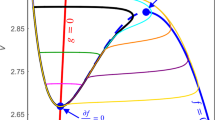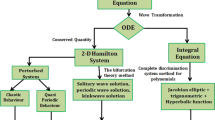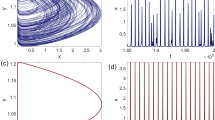Abstract
Synchronization phenomenon appears in several natural systems being associated with physical, chemical and biological processes. In brief, synchronization may be understood as a harmonization of two or more system behaviors following some patterns. This paper deals with synchronization analysis of a mechanical pendulum-chart system composed by a hierarchical network of three pendula coupled to each other through their own chart that receives continuous supply of energy via a base excitation. Dynamical patterns are classified and investigated in order to understand the conditions to each one of them. Asynchronous behaviors are analyzed including the chimera state defined as a symmetry break of the behavior of identical oscillator network. Numerical simulations indicate that patterns do not have a direct relation with periodicity. An energetic approach is proposed in order to define a measure of synchronized states, providing new insights about the origin of chimera state and its relationship with natural frequencies.





























Similar content being viewed by others
References
Huygens, C.: L’Horloge à pendule de 1651 à 1666. Travaux divers de physique, de mécanique et de technique de 1650 à 1666. Traité des couronnes et des parhélies (1662 ou 1663), vol. 17. Swets & Zeitlinger N. V., Amsterdam (1666)
Huygens, C.: Correspondance 1664–1665, vol. 5. Société Hollandaise des sciences, Amsterdam (1665)
Kapitaniak, M., Czolczynski, K., Perlikowski, P., Stefanski, A., Kapitaniak, T.: Synchronization of clocks. Phys. Rep. 517, 1–69 (2012). https://doi.org/10.1016/j.physrep.2012.03.002
Bennett, M., Schatz, M.F., Rockwood, H., Wiesenfeld, K.: Huygens’ s clocks. Proc. R. Soc. Lond. A 458, 563–79 (2002). https://doi.org/10.1098/rspa.2001.0888
Buck, J., Buck, E.: Mechanism of rhythmic synchronous flashing of fireflies. Science 159, 1319–27 (1968). https://doi.org/10.1126/science.159.3821.1319
Ravasz, E., Néda, Z., Vicsek, T., Brechet, Y., Barabási, A.L.: Physics of the rhythmic applause. Phys. Rev. E 61, 6987–92 (2000). https://doi.org/10.1007/BF02068742
Walker, T.J.: Acoustic synchrony: two mechanisms in the snowy tree cricket. Science 166, 891–4 (1969). https://doi.org/10.1126/science.166.3907.891
Wiener, N.: Nonlinear Problems in Random Theory. MIT Press, Cambridge (1958)
Wiener, N.: The human use of human beings: cybernetics and society, vol. 20. Free Association Books, London (1989). https://doi.org/10.1109/TIT.1974.1055201
Winfree, A.T.: Biological rhythms and the behavior of populations of coupled oscillators. J. Theor. Biol. 16, 15–42 (1967). https://doi.org/10.1016/0022-5193(67)90051-3
Kuramoto, Y.: Self-entrainment of a population of coupled non-linear oscillators. In: Araki, H. (ed.) International Symposium on Mathematical Problems in Theoretical Physics, pp. 420–422. Springer, Berlin (1975). https://doi.org/10.1007/BFb0013365
Czolczynski, K., Perlikowski, P., Stefanski, A., Kapitaniak, T.: Clustering of non-identical clocks. Prog. Theor. Phys. 125, 473–90 (2011). https://doi.org/10.1143/PTP.125.473
Pantaleone, J.: Synchronization of metronomes. Am. J. Phys. 70, 1–9 (2002). https://doi.org/10.1119/1.1501118
Ulrichs, H., Mann, A., Parlitz, U.: Synchronization and chaotic dynamics of coupled mechanical metronomes. Chaos 19, 1–6 (2009). https://doi.org/10.1063/1.3266924
Czolczynski, K., Perlikowski, P., Stefanski, A., Kapitaniak, T.: Huygens’ odd sympathy experiment revisited. Int. J. Bifurc. Chaos 21, 2047–56 (2011). https://doi.org/10.1142/S0218127411029628
Czolczynski, K., Perlikowski, P., Stefanski, A., Kapitaniak, T.: Clustering and synchronization of n Huygens’ clocks. Phys. A Stat. Mech. Appl. 388, 5013–23 (2009). https://doi.org/10.1016/j.physa.2009.08.033
Czolczynski, K., Perlikowski, P., Stefanski, A., Kapitaniak, T.: Clustering of Huygens’ clocks. Prog. Theor. Phys. 122, 1027–33 (2009). https://doi.org/10.1143/PTP.122.1027
Najdecka, A., Kapitaniak, T., Wiercigroch, M.: Synchronous rotational motion of parametric pendulums. Int. J. Nonlinear Mech. 70, 84–94 (2015). https://doi.org/10.1016/j.ijnonlinmec.2014.10.008
Strzalko, J., Grabski, J., Wojewoda, J., Wiercigroch, M., Kapitaniak, T.: Synchronous rotation of the set of double pendula: experimental observations. Chaos 22, 1–7 (2012). https://doi.org/10.1063/1.4740460
Kapitaniak, M., Lazarek, M., Nielaczny, M., Czolczynski, K., Perlikowski, P., Kapitaniak, T.: Synchronization extends the life time of the desired behavior of globally coupled systems. Sci. Rep. 4, 4391 (2014). https://doi.org/10.1038/srep04391
Kapitaniak, M., Czolczynski, K., Perlikowski, P., Stefanski, A., Kapitaniak, T.: Synchronous states of slowly rotating pendula. Phys. Rep. 541, 1–44 (2014)
Strogatz, S.H., Abrams, D.M., McRobie, A., Eckhardt, B., Ott, E.: Crowd synchrony on the Millennium Bridge. Nature 438, 43–4 (2005). https://doi.org/10.1038/43843a
Strogatz, S.H.: Exploring complex networks. Nature 410, 268–76 (2001). https://doi.org/10.1038/35065725
Osipov, G.V., Kurths, J., Zhou, C.: Synchronization in Oscillatory Networks. Springer, Berlin (2007)
Boccaletti, S., Latora, V., Moreno, Y., Chavez, M., Hwang, D.U.: Complex networks: structure and dynamics. Phys. Rep. 424, 175–308 (2006). https://doi.org/10.1016/j.physrep.2005.10.009
Dörfler, F., Bullo, F.: Synchronization in complex networks of phase oscillators: a survey. Automatica 50, 1539–64 (2014). https://doi.org/10.1016/j.automatica.2014.04.012
Pikovsky, A., Rosenblum, M., Kurths, J.: Synchronization: A Universal Concept in Nonlinear Sciences. Cambridge University Press, Cambridge (2003). https://doi.org/10.1063/1.1554136
Kapitaniak, T.: Continuous control and synchronization in chaotic systems system. Chaos Solitons Fractals 6, 237–44 (1995)
Blazejczyk-Okolewska, B., Brindley, J., Czolczynski, K., Kapitaniak, T.: Antiphase synchronization of chaos by noncontinuous coupling: two impacting oscillators. Chaos Solitons Fractals 12, 1823–6 (2001). https://doi.org/10.1016/S0960-0779(00)00145-4
Rosenblum, M.G., Pikovsky, A.S., Kurths, J.: Phase synchronization of chaotic oscillators. Phys. Rev. Lett. 76, 1804–7 (1996)
Pecora, L.M., Carroll, T.L.: Synchronization in chaotic systems. Phys. Rev. Lett. 64, 821–4 (1990). https://doi.org/10.1103/PhysRevLett.64.821
Boccaletti, S., Kurths, J., Osipov, G., Valladares, D.L., Zhou, C.S.: The synchronization of chaotic systems. Phys. Rep. 366, 1–101 (2002). https://doi.org/10.1016/S0370-1573(02)00137-0
Kurths, J., Boccaletti, S., Grebogi, C., Lai, Y.C.: Introduction: control and synchronization in chaotic dynamical systems. Chaos 13, 126–7 (2003). https://doi.org/10.1063/1.1554606
Pyragiene, T., Pyragas, K.: Anticipatory synchronization via low-dimensional filters. Phys. Lett. Sect. A Gen. At. Solid State Phys. 381, 1893–8 (2017). https://doi.org/10.1016/j.physleta.2017.04.005
Liu, X., Wu, C.: Fault-tolerant synchronization for nonlinear switching systems with time-varying delay. Nonlinear Anal. Hybrid Syst. 23, 91–110 (2017). https://doi.org/10.1016/j.nahs.2016.06.005
Dörfler, F., Chertkov, M., Bullo, F.: Synchronization in complex oscillator networks and smart grids. Proc. Natl. Acad. Sci. 110, 2005–10 (2013). https://doi.org/10.1073/pnas.1212134110
Blaabjerg, F., Teodorescu, R., Liserre, M., Timbus, A.V.: Overview of control and grid synchronization for distributed power generation systems. IEEE Trans. Ind. Electron. 53, 1398–409 (2006). https://doi.org/10.1109/TIE.2006.881997
Witthaut, D., Timme, M.: Braess’s paradox in oscillator networks, desynchronization and power outage. New J. Phys. 14, 083036 (2012). https://doi.org/10.1088/1367-2630/14/8/083036
Filatrella, G., Nielsen, A.H., Pedersen, N.F.: Analysis of a power grid using a Kuramoto-like model. Eur. Phys. J. B 61, 485–91 (2008). https://doi.org/10.1140/epjb/e2008-00098-8
Rohden, M., Sorge, A., Timme, M., Witthaut, D.: Self-organized synchronization in decentralized power grids. Phys. Rev. Lett. 109, 1–5 (2012). https://doi.org/10.1103/PhysRevLett.109.064101
Baldoni, R., Corsaro, A., Querzoni, L., Scipioni, S., Piergiovanni, S.T.: Coupling-based internal clock synchronization for large-scale dynamic distributed systems. IEEE Trans. Parallel Distrib. Syst. 21, 607–19 (2010). https://doi.org/10.1109/TPDS.2009.111
Klein, D.J., Lee, P., Morgansen, K.A., Javidi, T.: Integration of communication and control using discrete time Kuramoto models for multivehicle coordination over broadcast networks. IEEE J. Sel. Areas Commun. 26, 695–705 (2008). https://doi.org/10.1109/CDC.2007.4434294
Wang, Y., Nunez, F., Doyle III, F.J.: Increasing sync rate of pulse-coupled oscillators via phase response function design: theory and application to wireless networks. IEEE Trans. Control Syst. Technol. 21, 1455–62 (2013). https://doi.org/10.1109/TCST.2012.2205254
Simeone, O., Spagnolini, U., Bar-Ness, Y., Strogatz, S.H.: Distributed synchronization in wireless networks. IEEE Signal Process. Mag. 25, 81–97 (2008). https://doi.org/10.1109/MSP.2008.926661
Piqueira, J.R.C.: Using bifurcations in the determination of lock-in ranges for third-order phase-locked loops. Commun. Nonlinear Sci. Numer. Simul. 14, 2328–35 (2009). https://doi.org/10.1016/j.cnsns.2008.06.012
Correa, D.P.F., Wulff, C., Piqueira, J.R.C.: Symmetric bifurcation analysis of synchronous states of time-delayed coupled phase-locked loop oscillators. Commun. Nonlinear Sci. Numer. Simul. 22, 793–820 (2015). https://doi.org/10.1016/j.cnsns.2014.08.004
Piqueira, J.R.C., Oliveira, M.Q., Monteiro, L.H.A.: Synchronous state in a fully connected phase-locked loop network. Math. Probl. Eng. (2006). https://doi.org/10.1155/MPE/2006/52356
Giardina, I.: Collective behavior in animal groups: theoretical models and empirical studies. HFSP J. 2, 205–19 (2008). https://doi.org/10.2976/1.2961038
Saber-Olfati, R., Fax, J.A., Murray, R.M.: Consensus and cooperation in networked multi-agent systems. Proc. IEEE 95, 215–33 (2007). https://doi.org/10.1109/JPROC.2010.2049911
Bemporad, A., Heemels, M., Johansson, M.: Networked Control Systems. Springer, Berlin (1978)
Kuramoto, Y., Battogtokh, D.: Coexistence of coherence and incoherence in nonlocally coupled phase oscillators: a soluble case. Nonlinear Phenom. Complex Syst. 4, 380–5 (2002)
Abrams, D.M., Mirollo, R.E., Strogatz, S.H., Wiley, D.A.: Solvable model for chimera states of coupled oscillators. Phys. Rev. Lett. 101, 1–4 (2008). https://doi.org/10.1103/PhysRevLett.101.084103
Abrams, D.M., Strogatz, S.H.: Chimera states for coupled oscillators. Phys. Rev. Lett. 93, 174102 (2004). https://doi.org/10.1103/PhysRevLett.93.174102
Panaggio, M.J., Abrams, D.M.: Chimera states: coexistence of coherence and incoherence in networks of coupled oscillators. Nonlinearity 28, 67–87 (2015). https://doi.org/10.1088/0951-7715/28/3/R67
Tinsley, M.R., Nkomo, S., Showalter, K.: Chimera and phase-cluster states in populations of coupled chemical oscillators. Nat. Phys. 8, 662–5 (2012). https://doi.org/10.1038/nphys2371
Hagerstrom, A.M., Murphy, T.E., Roy, R., Hövel, P., Omelchenko, I., Schöll, E.: Experimental observation of chimeras in coupled-map lattices. Nat. Phys. 8, 658–61 (2012). https://doi.org/10.1038/nphys2372
Martens, E.A., Thutupalli, S., Fourrière, A., Hallatschek, O.: Chimera states in mechanical oscillator networks. Proc. Natl. Acad. Sci. 110, 10563–7 (2013). https://doi.org/10.1073/pnas.1302880110
Kapitaniak, T., Kuzma, P., Wojewoda, J., Czolczynski, K., Maistrenko, Y.: Imperfect chimera states for coupled pendula. DINAME 2015, 6 (2015). https://doi.org/10.1038/srep06379
Wojewoda, J., Czolczynski, K., Maistrenko, Y., Kapitaniak, T.: The smallest chimera state for coupled pendula. Sci. Rep. 6, 34329 (2016). https://doi.org/10.1038/srep34329
Wolf, A., Swift, J.B., Swinney, H.L., Vastano, J.A.: Determining Lyapunov exponents from a time series. Physica D 16, 285–317 (1985)
Acknowledgements
The authors would like to acknowledge the support of the Brazilian Research Agencies CNPq, CAPES and FAPERJ.
Funding
Funding was provides by Coordenação de Aperfeiçoamento de Pessoal de Nível Superior, Conselho Nacional de Desenvolvimento Científico e Tecnológico and Fundação Carlos Chagas Filho de Amparo à Pesquisa do Estado do Rio de Janeiro.
Author information
Authors and Affiliations
Corresponding author
Ethics declarations
Conflict of interest
The authors declare that they have no conflict of interest.
Additional information
Publisher's Note
Springer Nature remains neutral with regard to jurisdictional claims in published maps and institutional affiliations.
Rights and permissions
About this article
Cite this article
Carvalho, P.R., Savi, M.A. Synchronization and chimera state in a mechanical system. Nonlinear Dyn 102, 907–925 (2020). https://doi.org/10.1007/s11071-019-05441-4
Received:
Accepted:
Published:
Issue Date:
DOI: https://doi.org/10.1007/s11071-019-05441-4




